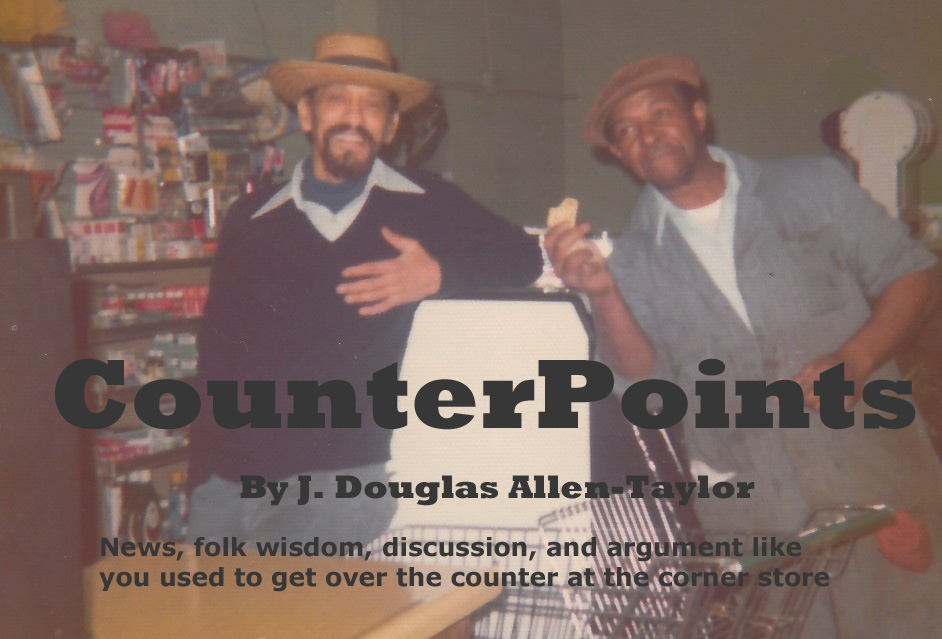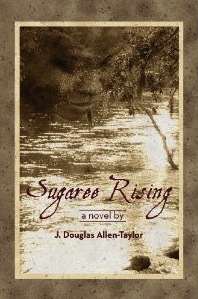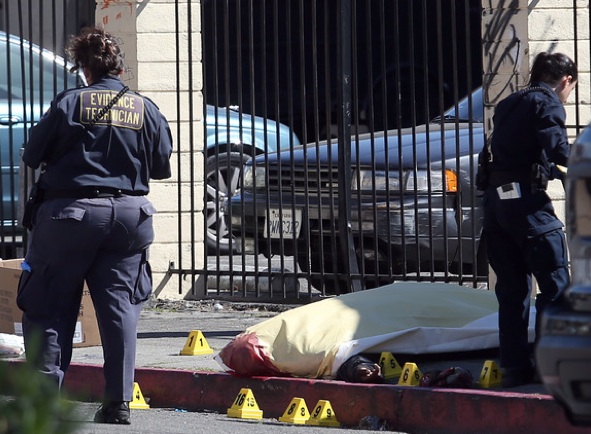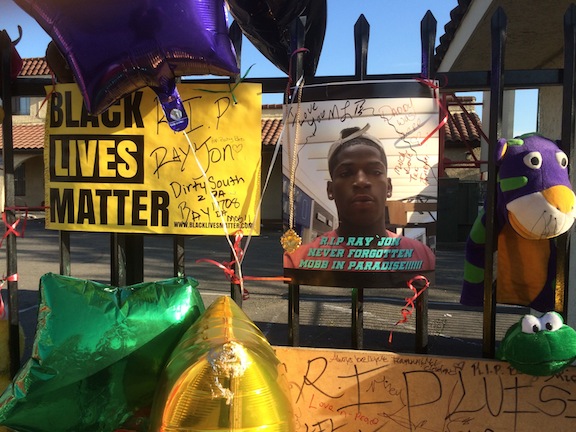|
|
The Overlooked Death Of Rayjon Simmons April 22, 2015 Do Black lives really matter? The answer is, it depends…depends upon which Black lives you’re talking about being mattered, and who is doing the mattering. Sadly, an example comes immediately to mind. This spring, as it has for the past several years, the Oakland Tribune published a summary of the past year’s Oakland homicides. This year’s story included a slideshow of photos from the 94621 zipcode in the city’s Elmhurst District—what’s commonly referred to as Deep East Oakland—because that section of the city had the highest number of murders, 17, of any zipcode in Oakland last year. One of those photos in this year’s Tribune Oakland murder summary was actually from a murder that occurred earlier this year, not in 2014. It showed a young African-American man standing next to an Elmhurst District street shrine. The caption reads: “Ryan Lyons hangs out near a memorial on 89th Avenue at International Boulevard in East Oakland… The memorial is for Rayjon Simmons, 19, who was shot and killed there on Feb. 27, 2015.” You can be forgiven if the circumstances of Mr. Simmons’ murder are not at all familiar to you. That’s because when the Tribune ran the original story about Rayjon Simmons’ murder in late February, they did not even report his name. Instead, alongside a series of photos of the crime scene in the online version, the Tribune story simply read that: “Oakland police investigate the scene of a fatal shooting on 89th Avenue at International Boulevard in East Oakland, Calif. on Friday, Feb. 27, 2015. The shooting happened about 10:30 a.m. when officers responded to find a 19-year-old Oakland man with multiple gunshot wounds. He was pronounced dead at the scene.” As far as I can tell, that was the only thing the Tribune mentioned about Mr. Simmons’ death until the photo of his street shrine appeared in the annual Oakland murder issue. No other media outlet appeared to have touched the Simmons story at all. And if any city or police official expressed any concern about Mr. Simmons or his murder, I missed it entirely. Intentionally or not, the impression left was that Rayjon Simmons was simply one more young Black man murdered among many young Black men murdered in the high-crime, drug-dealing neighborhoods of Oakland’s Forgotten Lands. Contrast the handling of the Rayjon Simmons murder with two Oakland murders that happened almost immediately afterwards. On the day after Rayjon Simmons was murdered in the Elmhurst, 14 year old Oakland Tech student Davon Ellis was shot and killed while walking with friends in the Fruitvale. A little over a week later, 30 year old Kaiser human resources worker Chyemil Pierce was shot and killed while trying to get her young children out of the range of fire from a gun battle on her West Oakland street. The response from Oakland city and police officials was immediate. Bay City News wrote that Oakland Police Chief Sean Whent saying that the Oakland Police Department was mourning Ellis’ death along with the teen’s family and the Oakland community. "All violent crime is tragic,” the news service reported Whent as saying, the chief adding, “but when the victim is a child it is even more so. The members of my department and I are committed to the safety of everyone in our community, especially our children." And after Pierce’s murder in West Oakland, the Oakland Tribune quoted Oakland Mayor Libby Schaff calling Pierce’s death "a tragedy," adding that Oakland “cannot flourish as a city under siege. We must come together to end the violence." A few days afterwards, Chief Whent came out with a half-dozen other OPD officers to a West Oakland community meeting to answer questions from Pierce’s family and the public and to pledge his department’s resources to finding the young woman’s killers. Meanwhile, the Tribune and local television and radio stations went full force on both the Ellis and Pierce murders, publishing or airing several stories covering community reaction and the efforts by OPD to solve the two cases. Coincidentally or not, in a city where most murders go unsolved and even unnoticed, suspects in both the Ellis and Pierce killings were arrested within days of the victims’ deaths. Like Mr. Simmons, both Davon Ellis and Ms. Pierce are African-American. So the issue here is not race, but a line drawn in the media and public mind over which deaths—even among African-Americans—are worthy of our general attention, and which ones are not. One might argue, if you like, that it was the compelling circumstances of their lives that caused our hearts and our sympathies and—therefore—our city’s resources to go out to Davon Ellis and Chyemil Pierce, one a young football player and student, the other a young working mother, both trying to survive and succeed in one of the toughest cities in the country. Or one might argue that it was the special circumstances of the Pierce killing—a young mother dying while saving her children—that caused our hearts to go out to her. The problem with that argument is, we have no idea if Rayjon Simmons’ life story was equally compelling, or what circumstances occurred in the moments when he lost his life on 89th and International. Who was Rayjon Simmons? Was he a student, or unemployed, or working someplace? What high school did he go to? Was he married, or did he have a girlfriend? Did he have any children? What about his family or friends? Of these things, the general public knows nothing. And what about his murder? Was there one assailant or more than one? Were there witnesses? Did any of the business cameras along that portion of International capture the shooting? And, most important, why was he killed? Are Oakland police actively trying to find out, or is Rayjon Simmons simply a name buried in a file underneath 25 or 30 other files on some Oakland homicide detective’s desk, waiting for a “break” that may or may not ever come? You might have learned something about Rayjon Simmons if you had visited the street sign erected in his honor at the spot of his murder on 89th and International and read the messages and viewed the pictures put up by friends and family, the balloons and candles and other icons growing daily until it blocked out a whole section of the fence. But 89th and International is not a part of Oakland where most residents care to go, and so the chance was lost. The shrine is gone now, taken down suddenly not many days after the Tribune featured it in their Oakland deaths recap issue. Why did most of us overlook the death of Rayjon Simmons? All three of victims mentioned in this column—Simmons, Ellis, and Pierce—were African-American, but that doesn’t mean that race did not play a factor in our general disinterest. Perhaps the answer is simply that most of us were waiting around for someone to tell us—on Twitter, on Facebook, or in the general media—that there was something about Rayjon Simmons’ death that made it important enough for us to become interested. Or maybe the answer is more complex. Whatever the case, there’s no doubt that Oakland’s general public didn’t consider the death of Rayjon Simmons to be worthy of special concern, if we even knew about his murder and thought about it at all. Hell, most who read about his murder in the Tribune weren’t concerned enough about Rayjon Simmons to even bother to find out his name. Do Black lives really matter, all Black lives? I don’t know, friends. You tell me.
|



